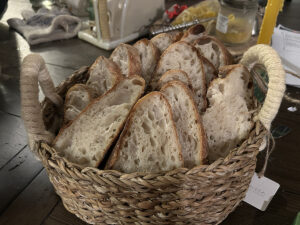Editor’s Note: We are pleased to share the thoughts and musings of our local Amish neighbors, as published in Plain Values Magazine. This series covers questions ranging from religion to education in the Amish community. Today, Ivan Keim shares his thoughts on agriculture and manufacturing.
By Ivan Keim
“What does restoration look like in your community?”
When there is a catastrophe in our community, causing damage to property or buildings, many of the community members come together to help clean up and rebuild. This summer, we had a damaging windstorm go through our community. Many people pulled together, cleaning up the damage, helping to rebuild the destroyed buildings, and cleaning up the many downed trees.
In order to be able to restore something, like Nehemiah, we must come to the realization that something is in need of repair or rebuilding.
The first order of business upon arriving in America was to clear the land and plant their crops. They continued to restore the areas they inhabited to become productive for their sustenance.
Most of the Amish continued to be involved in some sort of agriculture-related occupation through the 1950s and 1960s. Over the last 75 years, that has gradually changed.
According to research done in the Ohio Amish Directory, in 1980, 55% of our households were occupied in farming and other agriculture-related occupations. The rest were in construction, manufacturing, and woodworking, along with a few other outlying occupations. Twenty years later, in 2000, we had 30% of our families making a living off agriculture-related activities, while almost 40% of our population was involved in lumber or woodworking-related occupations. We fast forward another twenty years to 2020, and our agriculture-related occupation has dwindled to only 20% of the population, with construction, lumber, and woodworking occupying 60% of our people.
Our Amish community has shifted from being an agriculture-related community to being a manufacturing community. We are known throughout the country for quality and craftsmanship. This shift has also affected the way that we live. As our livelihood has shifted away from agriculture, our discretionary income has increased. We see more leisure time and a consumer-minded lifestyle. Do we consume more of our food than we produce? How much of the food that we eat was raised on our property or farm? How much of it was raised within five miles or within our community?
While the majority of us are no longer making our living off the farm, our children can still enjoy the values that come with an agrarian lifestyle. We can do this by putting our hands in the dirt or teaching animal husbandry to the next generation.
In recent years there seems to be a spark rekindling amongst our people to raise more of our own food. Families are planting more vegetables and fruit trees and butchering their own animals. The joy and values that a family experiences when the first berries ripen or when the pig has a new litter of piglets cannot be replicated. Oh, the joy after a day of butchering and packaging the meat in our canning jars and freezers. The taste of the juicy peach as you bite into it and juice dribbles down over your chin. You stand reveling among the fruit trees in awe of a Creator who allows the seasons to come and go. He ordained the… seedtime and harvest, and cold, and heat, and summer and winter…
*****
Ivan, Emma, and their four children live on a 12-acre homestead where they strive to raise as much of their own food as possible. Each year they have a large garden, harvest from their orchard, use milk from their own cow, and process chicken, turkey, beef, and pigs for their freezers. Ivan is a minister in the local Amish community. He builds tiny homes and animal shelters for a living. His models can be seen on tinyhomeliving.com or by calling 330-852-8800.
































I love to see this kind of article, because the Amish have continued their family values over the many years, and the rest of the populace have not. Oh, they love the lifestyles, but it is too much work to maintain it, so they go the way of the world, and will soon be regretting it. Prices are so high for everything, we are all going to wish we had a container garden on the deck of our high rise apartments. God bless these folks, and God bless Lehmans for providing for us that which we cannot pride for ourselves in living a more natural life, one that depends on God for the seasons, and lives by the fruit of their labors. Mother, grandmother, great grandmother, country living and loving it. Jacky